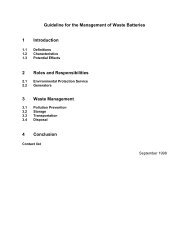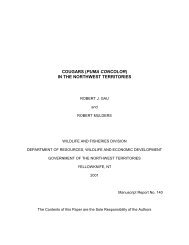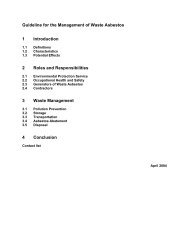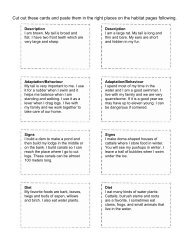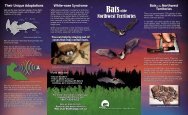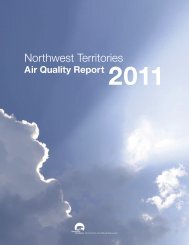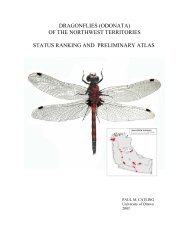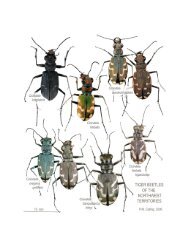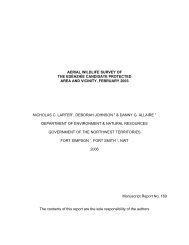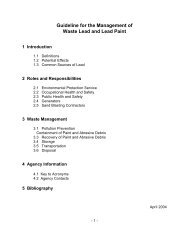Standard Operating Procedure (SOP) - Environment and Natural ...
Standard Operating Procedure (SOP) - Environment and Natural ...
Standard Operating Procedure (SOP) - Environment and Natural ...
- No tags were found...
You also want an ePaper? Increase the reach of your titles
YUMPU automatically turns print PDFs into web optimized ePapers that Google loves.
<strong>St<strong>and</strong>ard</strong> <strong>Operating</strong> <strong>Procedure</strong> (<strong>SOP</strong>)<br />
Capture, H<strong>and</strong>ling & Release of Bears<br />
Wildlife Care Committee Primary Author: Dr. Marc Cattet Version 2 - 2011<br />
<br />
carry aboard a helicopter) <strong>and</strong> administered to animals by use of a miniregulator<br />
<strong>and</strong> nasal cannula. A flow rate of 5-10 liters per minute is required<br />
for most bears <strong>and</strong> the efficacy of treatment should be monitored with a pulse<br />
oximeter (Caulkett <strong>and</strong> Cattet 2002). The availability of medical grade<br />
oxygen provides an invaluable aid to assisting field anesthesia of bears,<br />
especially when used in conjunction with a pulse oximeter (Cattet et al. 2003,<br />
Reynolds et al. unpublished report). This equipment is available from most<br />
ambulance supply companies <strong>and</strong> is recommended as a st<strong>and</strong>ard component<br />
of the capture equipment. This equipment is also useful for supportive care<br />
of field personnel following significant drug exposure.<br />
All capture data, including drug doses <strong>and</strong> measures of physiological<br />
function, must be recorded on data forms at the time of capture <strong>and</strong><br />
h<strong>and</strong>ling. Additional data recorded should include time of darting, number<br />
of darts used, start <strong>and</strong> end times of procedure, time bear spent in sternal<br />
recumbancy <strong>and</strong> body condition score.<br />
These data are invaluable in investigating health complications or the death<br />
of a bear during or following h<strong>and</strong>ling. A template for a capture data form is<br />
provided in Appendix B.<br />
4.2 Sample Collection <strong>and</strong> Measurements<br />
Recommendations:<br />
All h<strong>and</strong>ling, including sample collection <strong>and</strong> measurements, must be<br />
completed quickly <strong>and</strong> quietly with the objective of minimizing the h<strong>and</strong>ling<br />
time, <strong>and</strong> releasing the animal as soon as possible.<br />
Samples <strong>and</strong> measurements must be consistent with the experimental<br />
design <strong>and</strong> details provided in the animal h<strong>and</strong>ling protocol.<br />
Extraction of a premolar for the purpose of aging must only be done if<br />
„age in years‟ is data critical to the study objectives.<br />
Otherwise, age or age class should be estimated based on body size <strong>and</strong><br />
appearance.<br />
Local or regional anesthesia should be provided to manage pain resulting<br />
from premolar extraction. However, investigators must receive training by<br />
a licensed veterinarian before applying either of these procedures.<br />
Extraction of a tooth produces strong, long-lasting, painful stimuli associated<br />
with tearing of the periodontal ligament <strong>and</strong> sensory nerve supply. Where<br />
premolar extraction is justified, local or regional anesthesia should be<br />
provided to manage pain during the procedure <strong>and</strong> in the hours following<br />
h<strong>and</strong>ling (Holstrom et al. 2004). Although different local anesthetics are<br />
available, 0.5% bupivacaine is recommended for the long duration of<br />
analgesia it provides, i.e., 6-10 hours. Local anesthesia is accomplished by<br />
injecting anesthetic (e.g., 1 ml of bupivacaine) into the periodontal space <strong>and</strong><br />
gingiva surrounding the premolar approximately 10 minutes prior to<br />
extraction. Regional anesthesia is accomplished by using either an<br />
infraorbital nerve block for an upper premolar, or a mental nerve block for a<br />
18



